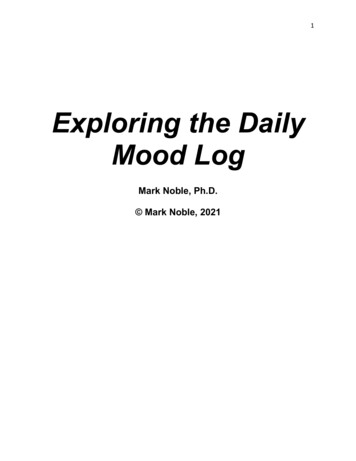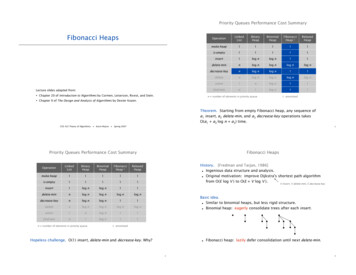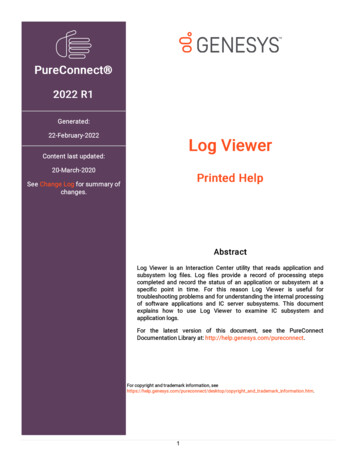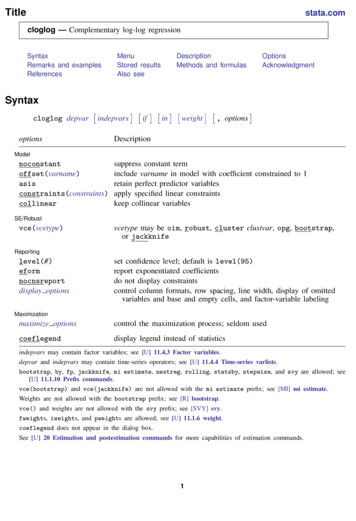
Transcription
1Exploring the DailyMood LogMark Noble, Ph.D. Mark Noble, 2021
2PrefaceThis guide provides an overview of the Daily Mood Log (DML), one of the critical tools used incarrying out TEAM CBT (or TEAM therapy, as it’s also called). More than that, the DML isessential in understanding the structure of this therapeutic approach, and in understanding whyTEAM CBT is so powerful.While discussing the DML in the www.feelinggood.com podcast #275 with Drs. David Burns andRhonda Barovsky, I made the comment that I thought that this was one of the greatestinventions in the history of psychology. After I said that, I immediately thought “Yikes – that’s apretty strong statement. Am I being too enthusiastic? Will the listeners find a claim like that tooexuberant?”No, that’s not quite accurate. I worried that people might think “Single session cures?Overcoming therapeutic resistance with positive reframing and a Magic Dial? A few pieces ofpaper is the greatest invention in psychology? Is this some weird psychological cult group?”The claim I made about the DML is a strong one, and I imagine a few people (probably morethan a few) will think that it was overly enthusiastic. (The same reaction is frequent, by the wayin regards to claims about being able to treat depression and anxiety in a small number oftherapy sessions, without using medications.) I actually hope that’s how people react, becausewe have a saying in science that extraordinary claims require extraordinary evidence.On the podcast, there was only enough time to talk about a couple of reasons for my views onthe DML, so I’ve added some additional thoughts on this topic in this guide, which can bedownloaded along with the Brain User's Guide to TEAM Therapy. I wrote quite a bit about theDML in the User’s Guide, so it’s useful to read that first. This is particularly the case becausethe User’s Guide is where there is more information on attempts to understand TEAM CBT fromthe perspective of brain function. Some of what I've written here overlaps with information in theUser's Guide, but writing a focused essay on the DML gave me the chance to add more detailsand to consider some topics that couldn’t fit into the podcast or the User's Guide. Thus, there’salso a fair amount of additional information in this document.The DML is central in understanding the most important question in TEAM CBT, which is howrapid emotional recovery is possible - and in the hands of the best TEAM therapists can occur ina few sessions. I’m particularly interested in how it’s possible to get rapid change in someonewho has not benefitted from working with other therapists and using a variety of medications foryears, even for decades. Seeing this happen is a remarkable experience, and understandinghow it happens strikes me as one of the great challenges in psychology.Rapid change, particularly when it occurs for someone who has not benefited from years ofother therapies, seems like magic. But, as the late Arthur C. Clarke wrote, “Any sufficientlyadvanced technology is indistinguishable from magic.” Although there is no electronic,biological or chemical technology in TEAM CBT, we can think of it as an advanced technologyof the mind. It’s not magic. It’s something that is understandable.For anyone who encounters TEAM CBT for the first time, and even for therapists who havebeen studying this approach, the rapid change that occurs routinely in the hands of therapistslike Dr. Burns is difficult to understand. In fact, having that reaction the first time I observed atherapy session was one of the reasons I became so interested in understanding TEAM CBT.
3Now, you might not believe in the possibility of rapid medication-free change. That’s fine. I’mnot going to try and convince you otherwise. If you do have such beliefs, I do have threequestions for you: Have you listened to some of the multiple podcasts of live sessions available on thewebsite www.feelinggood.com ? There are quite a few of them that demonstrate thatrapid change is possible, even for people with severe depression, anxiety, OCD andother problems. If you have listened to such podcasts, then why would you make the decision to ignorethe evidence that rapid change is possible? If you haven’t listened to the podcasts, but still don’t believe in the possibility of rapidmedication-free recovery from depression and anxiety, then is it possible that you’rejumping to a conclusion without examining the evidence?If you’re curious about how high-speed treatment works, I think that understanding the DML isessential. You, dear reader, may disagree with me about the importance of this tool. You maydisagree about the possibility of high speed, medication-free, change. Before you embracethose conclusions, however, let’s examine some of the evidence together. After we’ve donethat, if you can think of anything in the psychology toolbox that accomplishes more than theDML, please let me know. If you think of aspects of the DML I’ve left out, please let me knowabout those also. And if you think the high-speed change that is documented in a variety ofpodcasts at www.feelinggood.com is not possible, then I’m curious to know why that is.I’ve tried to provide enough detail here to begin a discussion about how to get the most out ofusing the DML and about why the DML is a remarkable invention. Even with the informationprovided here, however, this is still only a portion of what I think is interesting about thisinvention. But I hope it’s enough to get the conversation started.There are just two more comments to add before we start: (i) First, the ideas in this essay havebenefited enormously from my conversations with a large and growing number of TEAMtherapists, but most particularly from interactions with David Burns, Rhonda Barovsky, LeighHarrington, Richard Lam and Jill Levitt. The ideas that I’ve gotten correct are due to them, andthe parts that are wrong are entirely due to me. Whether right or wrong, the ideas I proposemay or may not be shared by the above therapists, by the University of Rochester (where Icurrently work) or by anyone else. (ii) Second, as with the User’s Guide, this essay iscopyrighted under a Creative Commons License. That gives others a lot of freedom fordistributing this information, translating it into other languages, and using it for various purposes.The only thing that’s not allowed is putting your name on it and presenting it as your own work,either for free distribution or for sale. Other than that, if you want to send your copy to someoneelse, please go ahead and do so.With warm wishes to you all,Mark NobleDecember 2021
4Table of ContentsPrefaceIntroductionSolving years of problems by working on a single moment in time and harnessing the biologyof nerve cell networks.Defining your feelings in more detailWhat is the intensity of each of your feelings?Identifying your negative thoughtsAmplifying curiosity with the magic button questionDiscovering what’s right about you with positive reframing: Changing your internal story andharnessing the power of desirability biasOvercoming therapeutic ambivalence (also known as therapeutic resistance) with the MagicDialIdentifying cognitive distortions helps you crush belief in your negative thoughtsRe-examining the intensity of your feelingsSome final thoughts on the DMLAbout the authorIntroductionFirst, just to be clear on language, the DML is an invention, and not a discovery. An inventionis when you create something new that did not exist before. In contrast, a discovery is whenyou find something that already exists but you just didn’t know about it. Inventions are based ondiscoveries, but they’re not the same thing.The distinction between an invention and a discovery is important because I’m going to writeabout why the DML is an important invention, and also about the discoveries made using it.Earlier versions of the DML were already based on multiple discoveries, and brought themtogether in a novel way. Using the DML has enabled still more discoveries, which are used inturn to further refine this invention. When you use the DML, you’re also going to get to makenew discoveries. If you’re using it personally, you’ll get to make new discoveries aboutyourself. If you’re using it to work with someone else, both of you will get to make newdiscoveries about how to enable effective and rapid recovery from depression or anxiety.The DML seems to me to fit into the most useful type of inventions, which are the ones that helpyou do something new, make new discoveries, and provide the detailed information you need totest new ideas in a quantitative way. All of science depends on the ability to measure whateveryou’re studying, and the more detailed the measurements are that you can make with aninvention, the more useful it is. The DML, particularly in its current form, fits all of thesecategories: it lets you do something new, helps you make new discoveries, and it providesdetailed quantitative information at every step.246891113131619212225
5But why make the claim that the DML is the most important invention in all of psychology? Toaddress that question, we need to start by considering what needs to be solved for people withdepression, anxiety or related problems.There’s a long list of challenges that need to be met to enable recovery from depression andanxiety. Regardless of your beliefs about the causes and treatment of depression and anxiety, Ihope we can agree that we need to: Identify what kind of problems need attention. Identify the cause(s) of unhappiness. Treat those causes. Be able to treat emotional problems that may have a history of years, or even decades,of unhappiness. Be able to solve a wide range of different emotional problems (e.g., different types ofdepression, anxiety, PTSD, OCD, phobias, etc.). Combine the ability to solve a range of problems with therapies personalized to thespecific needs of each individual – which presents a difficult paradox. How do youaddress the general problem of solving a wide range of emotional problems and at thesame time tailor therapy to the needs of each specific person? Know whether you’re making progress in a way that can be quantified and also isspecific enough to know where progress is being made and where it isn’t. Overcome confirmation bias. Our brains work in such a way that we often pay the mostattention to information that confirms what we already believe. Even worse, our brainsoften take information that shows we’re wrong and misinterprets that information toconfirm what we already believe. Overcome therapeutic resistance. This is one of the greatest challenges inpsychotherapy. It affects many people, it’s difficult to understand, and it’s hard toovercome. Make the therapeutic journey enjoyable, not stressful. Why is this? After all, if you havea bacterial infection, you don’t worry about whether taking antibiotics is enjoyable. Yet,for depression and anxiety, we are talking about the ability to experience joy in your life.A therapeutic journey that’s enjoyable is part of that process. Provide ways of preventing relapses.If you think depression and anxiety are caused by problems in thinking, then needs include suchthings as: Change the interpretations of the world that are causing unhappiness. Change the internal story, which you can think of as the “big picture” that ties togetherthe interpretations that in turn cause unhappiness. To accomplish the above goals, you need to modify ways of thinking. You also need to promote efficient learning of the new thinking patterns. You also need to promote the focused attention and alertness needed for effectivelearning. There needs to be a clear strategy for therapeutic homework that will be effective inhastening recovery.If you think depression and anxiety are caused by organic problems in brain function, thenperhaps you want to Harness the biochemistry of the brain in a way that works to your advantage instead ofyour disadvantage.
6 Correct altered functions in, e.g., the amygdala and the prefrontal cortex, that maycontribute to depression and anxiety.Achieve high speed recovery that is durable when treatment is stopped and that alsohas no side effects.Let’s add one more group of challenges that are too often ignored, which are the challenges ofcosts and availability of treatment. The number of people with emotional problems that interferewith their daily lives is large, and far exceeds the number of available therapists. In addition, thecosts of therapy are too high for many people. Thus, it would be preferable if therapies alsocould be: Inexpensive Accessible without a therapistIf there was a single device that helped you accomplish many of the above goals at one time, Ihope we could agree that this would be an important invention. If that invention could be usedto solve all of the above problems, and still others not even included in these lists, I hope we’dagree that such an invention would be a strong contender for the most important invention in thehistory of psychology.What if you could do this with a few pieces of paper? No fancy gadgets, no batteries needed,and no chemical interventions. What if the invention consisted of new ways of using yourbrain’s normal functions? Such an invention seems like it would be worth some specialattention.I’m going to present core aspects of the case that the DML can do all that I’ve discussed, andmore. Let’s see what you think as we take a step-by-step look at the DML and at what happensat each step of using this invention.*****Everything from this point on is meant to be read after you read the Brain User’s Guide to TEAMCBT first. If you haven’t read the User’s Guide yet, then please start there. Although there issome overlap with information in the Guide, for the most part I’m going to assume that you’refamiliar with concepts that are discussed there. That way I can add to this information.As I’m going to sometimes refer to sections of the User’s Guide, you may want to keep thatavailable in case you need to have another look at it.*****Solving years of problems by working on a single moment in time and harnessing thebiology of nerve cell networks. (Step 4 in the User’s Guide)You start the DML by picking a single moment in time that you’re going to work on. This isalready a major change from other types of psychotherapy, and is one of the critical discoveriesin the development of TEAM CBT. Working on a single moment has multiple benefits, such as: Working to understand a single moment makes sense because the reasons you’reunhappy on Tuesday of this week are the same reasons that you were unhappy onWednesday of last month, or Monday of last year.
7 Working on a single moment is much easier, however, than trying to unpack months oryears – or decades - of anxiety and/or depression. Choosing a single moment allowsyou to focus on something specific and defined, instead of wandering for a long timeacross all of your memories.Working on a single moment and understanding it in detail is also more effective thantalking in less detail about years of feelings.You’re hopefully choosing a moment when your unhappiness was particularly intense. Ifyou’re having a bad day right now, you can choose to work on the moment that’shappening right now. You can also choose the first moment when your problems began,if there was a particularly important event that you want to focus on. If you’re having agood day, then you can choose to work on a time that was not so good.Whatever moment you choose is fine. You are in charge of making these decisions, andno one is going to force a particular choice on you. As with everything else in TEAMCBT, the approach that you take is going to be personalized to your needs, includingchoosing the moment on which you want to focus.Because you’re the one making the choice, you’re less likely to be resistant to workingon that moment.Working on a single moment only makes sense, however, if this strategy works. If you’ve beendepressed, or anxious, or both, for weeks or months or years or decades, then how can workingon a single moment in time help you unravel a pattern of unhappiness that has lasted for solong?We discussed on the podcast (with more detail in the User’s Guide) that the power of workingon a single moment comes from the way the brain uses networks of nerve cells to organizeinformation. Even though the brain is extraordinary in its ability to store and process information,and has a lot of nerve cells, there are not enough cells and connections in the brain to have asingle one for every moment in our lives, or for every thought and feeling and memory that wehave. That’s the case for our large human brains, and it was even more true over the manymillions of years over which the most fundamental principles of brain function evolved. Thosebrains were smaller, and had fewer cells, but they had to solve the same problem that ourbrains need to solve. The central challenge for the brain is how to store and processinformation in a way that allows you to work with a limited number of cells.The way evolution seems to have solved the problem of needing to deal with more informationthan there are available cells to store and process that information is to use the same nerve cellnetworks whenever you encounter similar circumstances. Thus, although you’re technicallyworking on one moment in time with the DML, you’re also working to modify nerve cell networksthat are used over and over again when you’re solving similar problems. The example providedin the podcast and in the User’s Guide is the simple mathematics problem of 2 2. If you werewrongly taught that 2 2 5, then you’ll get the wrong answer in any mathematics problem whereyou need to add 2 2. If you correct this information one time, so that you’ve modified yournerve cell networks to give the correct answer of 2 2 4, making that change one time is enoughto let you get this answer right in any problem that you work on.The same principles that apply to nerve cell networks involved in solving mathematics problemsalso apply to nerve cell networks involved in interpreting the world. If you have a mistake inyour interpretations in one moment in time, then it’s just about certain that you’re making thatsame mistake at other moments in time. That’s true because your brain uses a lot of the samenetworks of nerve cells any time you’re in a situation that seems like one you’ve been in before.
8We do not know of any other way that the brain can solve the challenges of there being toomuch information to use separate cells for each one of the thoughts and moments in our lives,and of needing to retrieve information quickly and accurately.If you think about the effectiveness of working on a single moment from the perspective of howwe think the brain works, then it makes a lot of sense. The idea is that although you’retechnically working on one moment in time with the DML, you’re also working to modify nervecell networks that are used over and over again in different circumstances. If you try tounderstand the power of working on a single moment from any other perspective, however, it’shard to understand why this approach would be effective.Thus, right from the beginning, the DML is helping you do something new.Are there other possible advantages to working on a single moment? One that comes to mindis that this idea will stimulate your curiosity because of the novelty of this approach. You’rebeing told that this is not just an effective approach to changing your emotional life, but is in facta far more powerful one than anything you might have tried before. Does that statement makeyou at least a little bit curious?*****The next two sections of this document focus on ideas that are not developed in detail in theUser’s Guide, but that are critical in understanding some of what’s accomplished with the DML.Defining your feelings in more detailAfter you’ve chosen the moment that you’re going to work on, the next step is to identify theemotions you were feeling in that moment. Doing this is made easy because the top of theDML has a list of emotions. All you have to do to get started is circle the words that apply toyou.This simple list accomplishes multiple objectives: Having a list is a lot less stressful than trying to remember the words that describe yourfeelings. Having a list of choices provides the opportunity to define how you feel withoutthe stress of trying to remember the words you need to describe your feelings. The list on the DML has a lot of subtlety to it. There’s a lot of disagreement about howmany emotions exist, but the fact that we have so many words to describe our emotionsshows clearly that there are many emotions and that each of these emotions can bequite nuanced. The DML recognizes categories of emotions and nuances by organizingthe emotional descriptions in groups. For exampleØ The emotion of feeling Sad also includes blue, depressed, down, unhappy.Ø The emotion of feeling Inferior also includes worthless, inadequate, defective,incompetent.Ø The emotion of Lonely also includes unloved, unwanted, rejected, alone,abandoned.Ø The emotion of Angry also includes mad, resentful, annoyed, irritated, upset,furious. Having such a range of choices is important in describing how you’re feeling with muchmore specificity than exists in most emotional tests (including the Brief Mood Survey).
9 The broader lists are useful, but their emotional categories are too simple forpersonalized therapy.In addition, it’s rarely the case that there is only one emotion that you’re feeling. Ouremotional states have multiple components to them, and we generally have lots ofdifferent feelings at the same time. This list helps you think about the complexity of yourfeelings.Being able to choose from this list allows you to see, in a straightforward way, that if youcome to a therapist to treat depression, for example, there are a lot of different emotionsthat are in play at the same time.You may even see that there are negative emotions that you’re feeling very strongly, butwhich you haven’t even realized are part of how you’re feeling.Emotions are personal, and specific words mean different things to different people.What you call “annoyed” or “unloved,” another person might call “upset” or “abandoned.”That’s okay because you’re choosing words that mean something to you, and what’simportant is that you find words that resonate for you. If they mean something differentto someone else, even your therapist, it doesn’t matter. As the session goes on, youand your therapist are going to understand your feelings in all their complexity.By working on this list of emotional words, you’re also jogging your memory about otheremotional words that might describe your feelings. You might read through the list andsee that it’s missing words you need to describe your feelings, which will help youremember what words you want to use. In fact, there’s a section of this list that isreserved for describing still other emotions than the ones already provided.Despite all the information this list provides, however, it’s a very quick process to circlethe emotional words that apply to you.Remember that the first goal that needs attention in treating depression and anxiety is to identifywhat problems need attention. The DML approaches this challenge in a different way than justtalking, and provides a great deal more detail about your feelings.It would be very hard for this detailed description of your emotions to come out in conversationbecause you’d be spending so much time thinking about words. That’s not easy for everyone,and this approach makes it much easier. If you were trying to do this by talking, you’d also likelyget focused on a smaller set of emotions than are revealed by circling words in the list. Inaddition, if you were doing this by talking, you’d have to remember what your said. Now youdon’t have to do any of these things, because the DML makes it easy to remember all the wordsyou chose whenever you want to use them, and all you have to do is look at the top of the page.*****What is the intensity of each of your feelings?After picking the words that describe your feelings, the next step is to score how strongly youfeel them. As with choosing your emotions from the list, doing this has multiple benefits. Forexample: Instead of just saying that you feel sad or angry or hopeless, you’re defining youremotions with much more precision. This is more useful than simply saying that you feeldown, or nervous, or any of the vague descriptions people most often use to describetheir feelings.
10 Scoring the intensity of your feelings reveals more about the details of your emotions, asyou find out which are the ones that weigh on you the most heavily.There’s a score for each row, but if you want to give different scores to different words inthe row, then go ahead and do that. For example, let’s say that you circled “inferior” and“worthless” and “defective” in the same row, but you’re not feeling each of them with thesame intensity. You can write down different scores for each by writing down a numberand the first letter of the specific emotion next to the number.Scoring your emotions also provides information that will be important throughout theuse of the DML because by scoring the intensity of your feelings, you’ve defined yourstarting point with precision. This means you’ll easily be able to tell if the intensity ofyour feelings changes and how much they change.Having scores for individual emotions also tells you whether some emotions aredecreasing in intensity but other emotions are not. This way, you know where you’resucceeding and where more work is needed.By combining subjective information about how you feel with measurements, the DML isdoing something surprisingly complex. Measuring your emotions is not like getting on ascale and finding out how much you weigh, or finding out what your blood sugar levelsare. You’re taking private states that seem unknowable to others in detail, and providingdetailed information about their intensity.For medicine, as for all other parts of successful science, the ability to make accuratemeasurements is the key to both accurate therapy and to making great advances.Psychotherapy can only benefit from following in this path. It was because of the ability tomeasure outcomes that CBT could be established as beneficial. It was because of the ability tomeasure emotions in more detailed ways, with tools like the earlier versions of the DML, that itwas possible to progress from CBT to TEAM CBT.That’s not, however, all that’s going on even at this early stage of working with the DML. Inaddition to the above considerations, you’re thinking in an alert and focused manner as youdecide whether each particular word describes your emotions. You’re paying attention to howstrongly you feel each emotion. The attention to what you’re doing also is increased by the factthat you’re using your visual system. Learning requires attention and focus, and using the visualsystem provides one of the most powerful means of achieving that focus very quickly. Asexplained in the User’s Guide, you’re also using your musculature as you circle words, and yourDailyPage 1 of 2memory about what the words mean. Multimodal approachesmake MoodlearningJournal*more effective,and the DML uses multimodal approaches throughout.Upsetting Event:Emotions% Now% Goal% AfterEmotionsSad, blue, depressed, down, unhappyEmbarrassed, foolish, humiliated, seAnxious, worried, panicky, nervous, frightenedHopeless, discouraged, pessimistic,Guilty, remorseful, bad, ashamedFrustrated, stuck, thwarted, defeateInferior, worthless, inadequate, defective, incompetentAngry, mad, resentful, annoyed, irritLonely, unloved, unwanted, rejected, alone, abandonedOtherNegative Thoughts1.2.% Now David Burns% AfterDistortions
11You’re also using analytical thinking (and associated parts of your brain) to decide which wordsapply to you and which ones don’t. Working with your analytical thinking abilities is what youneed to do proceed to the next step in the therapeutic journey.Another thing that’s hopefully happening is that your curiosity is being stimulated in differentways. For example, right next to the column in which you’re scoring your emotions is anothercolumn labeled “goals,” and then another column labeled “after.” What are those for? And whatabout all the other spaces on the DML?*****Identifying your negative thoughtsThe next step in using the DML is to use your emotions as clues to find out the ways in whichyou think about yourself and the world.The core hypothesis in all cognitive therapy is that our emotions are the result of how we thinkabout what happens to us. They are not the result of an event. Instead, they are the result ofour interpretation of the event. This hypothesis stretches back at least to Stoicism and, furtherback, to the origins of Buddhism, and has been tested in many different ways. It continues to beone of the most solid hypotheses in all of psychology.The idea that our emotions arise from our interpretations sounds simple, but can be hard formost people to grasp until they start doing the experiments on themselves. When things aregoing well, or even decently, you can do this experiment by examining your memories. It will beeasy to remember times when you were sad, or angry, or felt hopeless about a situation, butwhen you changed your interpretation, your emotions changed in an instant. As discussed inthe first section of the User’s Guide, this is how your brain works. Emotions need to align withyour interpretations and predictions so that you do what your brain believes will increase yourchances of survival. When your brain carries out a “quality control check” on yourinterpretations, and decides that they’re wrong and need to change, then when theinterpretations change the emotions
together in a novel way. Using the DML has enabled still more discoveries, which are used in turn to further refine this invention. When you use the DML, you're also going to get to make new discoveries. If you're using it personally, you'll get to make new discoveries about yourself.











